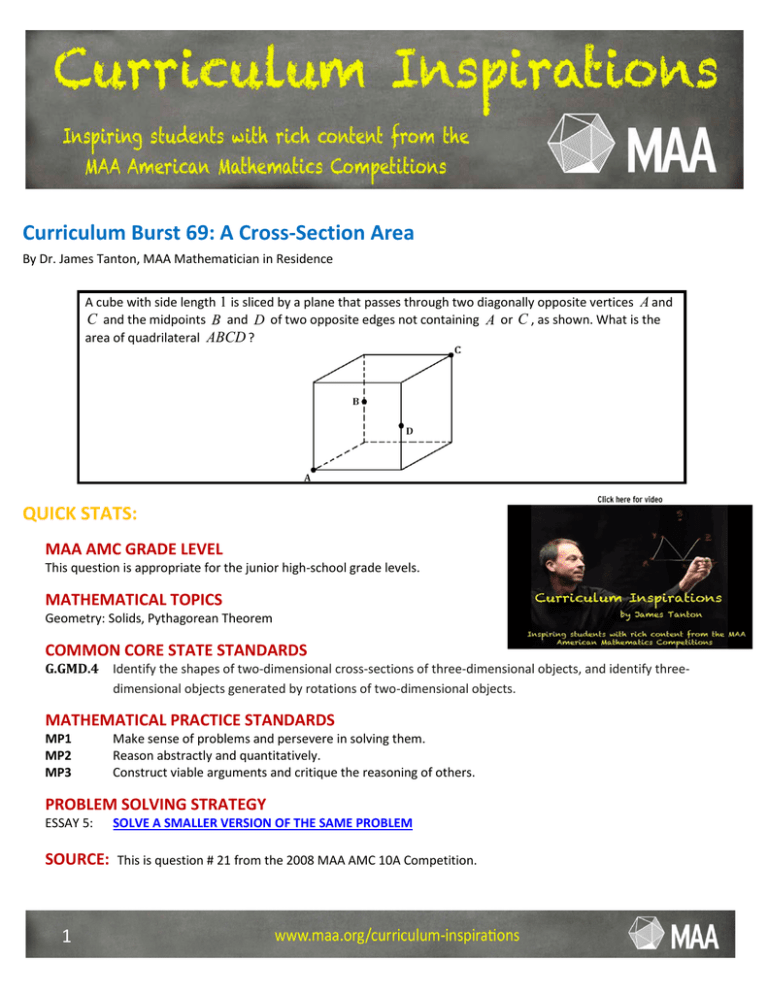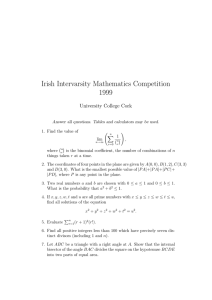Curriculum Burst 69: A Cross-Section Area
advertisement

Curriculum Burst 69: A Cross-Section Area By Dr. James Tanton, MAA Mathematician in Residence A cube with side length 1 is sliced by a plane that passes through two diagonally opposite vertices A and C and the midpoints B and D of two opposite edges not containing A or C , as shown. What is the area of quadrilateral ABCD ? QUICK STATS: MAA AMC GRADE LEVEL This question is appropriate for the junior high-school grade levels. MATHEMATICAL TOPICS Geometry: Solids, Pythagorean Theorem COMMON CORE STATE STANDARDS G.GMD.4 Identify the shapes of two-dimensional cross-sections of three-dimensional objects, and identify threedimensional objects generated by rotations of two-dimensional objects. MATHEMATICAL PRACTICE STANDARDS MP1 MP2 MP3 Make sense of problems and persevere in solving them. Reason abstractly and quantitatively. Construct viable arguments and critique the reasoning of others. PROBLEM SOLVING STRATEGY ESSAY 5: SOURCE: 1 SOLVE A SMALLER VERSION OF THE SAME PROBLEM This is question # 21 from the 2008 MAA AMC 10A Competition. THE PROBLEM-SOLVING PROCESS: As always, one starts the problem-solving process with … STEP 1: Read the question, have an emotional reaction to it, take a deep breath, and then reread the question. This question doesn’t feel too scary to me. I think I can see that there is a plane that slices the cube through all four of the points as described in the question: I know the side-lengths of this triangle. BD = the diagonal of the square = 12 + 12 = 2. 2 5 1 AD = 12 + = 2 2 and BD = AD . This triangle has base 2 h= (Hang on! I know through any three points there is a plane. So there is a plane that goes through the points A , B , and D , for sure, and there is a plane that goes though the points B , D , and C . I guess the question says that these two planes are the same. I think I can believe that.) So I need to figure out the area of the cross-section I shaded. It looks like all four sides of that cross-section quadrilateral are the same length (“one side-length over and half a side-length up”) so that shape is a rhombus. I do know there is some formula for the area of a rhombus that I learned about in geometry class. I can’t remember it now. Hmm. Well, I can break the quadrilateral into the two triangles I first thought of, ∆ABD and ∆CBD , and work out those areas instead. And by symmetry it looks like these are identical triangles. Let’s find the area of just one of them. (That’s a smaller and easier version of the problem, and it avoids knowing a special formula for the area of a rhombus!) 2 and height 2 5 2 − = 2 2 3 , and so its area is: 2 1 3 6 ⋅ 2⋅ =. 2 2 4 The area of the rhombus is double this, namely 6 . 2 Aside: Prove that the area of a rhombus is half the product of the lengths of its two diagonals. Extension: Find a plane through the center of the cube that yields a cross-section area larger than the one described in this question. Which plane through the center of the cube yields the cross-section of largest area of all? (And what is that largest area?) Which plane though the center yields a cross-section of smallest area? Curriculum Inspirations is brought to you by the Mathematical Association of America and the MAA American Mathematics Competitions. 2 MAA acknowledges with gratitude the generous contributions of the following donors to the Curriculum Inspirations Project: The TBL and Akamai Foundations for providing continuing support The Mary P. Dolciani Halloran Foundation for providing seed funding by supporting the Dolciani Visiting Mathematician Program during fall 2012 MathWorks for its support at the Winner's Circle Level 3

